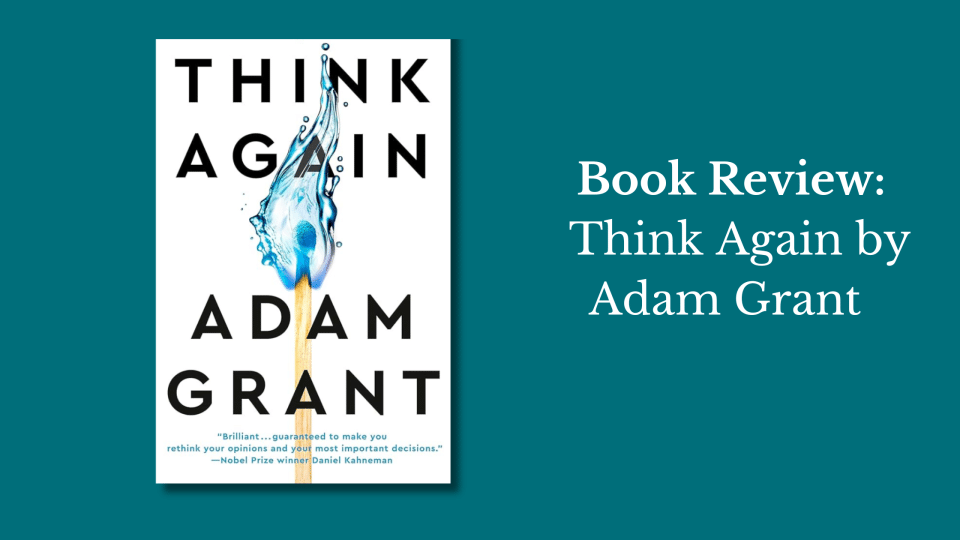Book Review: Think Again by Adam Grant

I had forgotten that I had previously read Think Again. For a book about unlearning and relearning, this was a true meta (and ironic) moment. I picked this book up during a recent overseas trip in search of wanting a deeper understanding of how myself and others think, learn where we may have unconsciously become automated in our thinking (so thinking without realising that we’re thinking, and hence miss the opportunity to more consciously think about what we’re thinking about and change it if it’s not working in our favour), and, more importantly, how we can change what, how, and why we think.
How I came about reading this book.
I don’t recall when or how I first head of Adam, but I’m glad that I had and I’m glad that I had forgotten that I’d read Think Again and picked it up. Perhaps divine intervention…?
Adam Grant is one of those academics who has cracked the code to appeal to the corporate crowd in organisations across the world, and to a more general audience (kind of like Cal Newport). As an organisational psychologist, Adam writes and speaks regularly on work and psychology, and how we can do leadership better by learning and relearning about how ourselves and others can do both of those things. He is the author of four books, with an additional three co-authored books, and one Audible Original interview of World Economic Forum leaders. His TED Talks have been viewed more than 37million times.
Think Again in a nutshell.
The ability to rethink and unlearn is a valuable cognitive skill. In a world of rapid change and evolution, it’s something that we can all benefit from cultivating.
To first unlearn we must learn what we have learned, internalised, and rely on when making decisions. Most of this is done automatically but not always in our favour. We must bring the unconscious into the conscious. And this book is an invitation to do that.
Adam Grant provides methods – with compelling anecdotes – on how we can change our own and others’ thinking.
Get ready to confront your assumptions, instincts, beliefs, and habits and see how they may be sabotaging your interests and goals, and your ability to work with and through others to achieve desirable outcomes.
Why should you read Think Again?
Despite the numerous palm-to-face moments you may experience as some of your not-so-conducive mental models and behaviours are illuminated, the discomfort is worth the reward. The reward being improved decision-making, influence, and leadership, and the outcomes that come along with those.
For the boardroom, how to have constructive conflict is particularly fitting. A lot of times we avoid any sort of conflict, seeing it in the same emotional light as a fight or argument. Our threshold for sitting in the discomfort of a clash of ideas is small, so we quickly retreat to our comfort zone, missing the opportunity to get to the best outcome or decision. This is unsuitable for the boardroom.
In addition to radical truth and radical transparency (to borrow from Ray Dalio) being required for constructive conflict to occur, a high degree of self-awareness and a rigorous application of Adam’s approaches is required (especially, the willingness to be wrong). Not only are there steps that we can personally take to get better at constructive conflict, Adam also provides a whole section to interpersonal rethinking – how you can open other peoples’ minds.
This book is uncomfortable in all of the good ways, ironically illuminating to the reader all of the ways in which their assumptions, instincts, beliefs, and habits have been sabotaging their interests, goals, and relationships. A lot of what we get from people is a reflection of what we give to them; and we have more influence over our outcomes – particularly as they relate to our interactions with others – than we first realise. For those of us who are impatient (i.e., me) this is as frustrating as it is empowering.
Best piece of advice from Think Again?
What am I metaphorically and unconsciously carrying that may be holding me back?
In the prologue, Adam shares the story of a group of smokejumpers who got caught in the direct path of a forest fire. The group had to run for safety and survival. One smokejumper made the decision to start a smaller fire to avoid the larger fire, depriving a small area of fuel so that the larger fire ‘jumped’ over him thus surviving. Many other smokejumpers continued to run for the ridge to escape the larger fire. Unfortunately, twelve of them perished. Many of them were found still carrying their firefighting equipment – awes, saws, shovels, and heavy backpacks – even after they were instructed to drop their equipment. Imagine how much faster they could have run if they weren’t laden with their equipment? They were ‘running on autopilot, not even aware that they were still carrying their packs and tools.’ (pp 6-7).
The personal impact from Think Again.
Overall, what I take away from this book is that there can be immense value in seeking out information that may prove myself wrong. I’ve found it an invitation to bring my assumptions, instincts, beliefs, and habits to my awareness and examine if they are helping or hindering me, my goals, and my ability to work with and get the best out of others. Easier said than done when it feels good to believe that my opinion is the right one.
I’ll close with a useful question for us all to reflect on regularly: What have I been rethinking lately?
Get Think Again: The Power of Knowing what you Don’t Know by Adam Grant on Amazon
